Q:
I have a 275-gal. fuel-oil tank in my basement. Being of Scottish descent, I’d like to add a second tank so that I can buy an entire winter’s worth of fuel at blue-light special prices in the summer. How do I hook up a second tank?
Andy Engel, Roxbury, CT
A:
William Aitken, a licensed plumber in Alexandria, Virginia, replies: The answer to this question is simpler than you may think. You probably envision elaborate schemes for filling the tanks or for switching from one tank to the other automatically, but I recommend something much simpler.
First, you’ll need the tools and skills to cut and thread steel pipe as well as to sweat or to make flare joints in copper pipe. Basically, you just have to duplicate the installation of the existing tank. Each tank has two sets of plumbing, the fill and the feed.
After setting the new tank in the house (you did make sure you could get a second tank into the house, didn’t you?), start by putting a separate fill and vent for the new tank next to the fill and vent for the existing tank on the exterior wall. Both the fill and the vent are made of steel pipe with threaded connections.
Next, you’ll need to tie the two tanks into a common feed line to the furnace. First, turn off the valve on the 3/8-in. copper supply line at the base of the existing tank, and disconnect that line. Then take a new 3/8-in. copper line, and sweat a copper T into it. If the supply is made of soft, flexible copper, all the connections including the T should be made with flare fittings. The side inlet on the T is then connected to the new tank by means of another 3/8-in. supply line.
The new tank should have its own shutoff valve and oil filter. After you have both feed lines hooked up, turn on both valves. You may be thinking that you need to switch between tanks as they run out of oil, but I don’t recommend this procedure. Instead, allow both tanks to feed the furnace simultaneously. That way, there is no need for you to keep track of the levels in the two tanks and no need to worry about switching tanks at the proper time, which also reduces the chance of one tank running dry.
If this installation sounds confusing, I recommend hiring a professional to do it for you. I’d also remind you to check with your local building official to make sure that all the state and local ordinances regarding permits and inspections are followed properly.

























